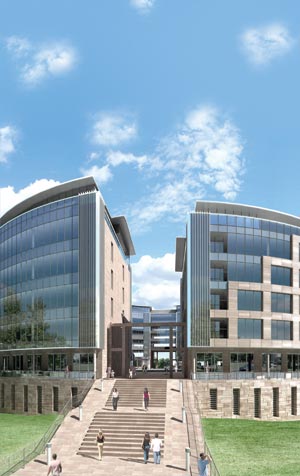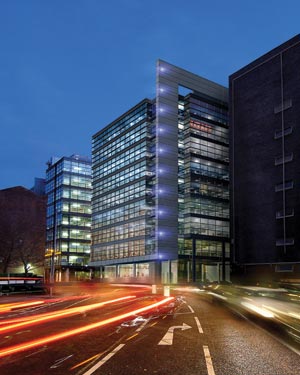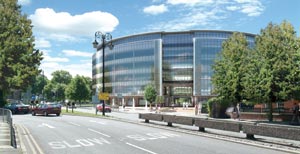Visualisation One is one of the UK’s leading 3D architectural illustration and multimedia companies. Skilstream’s John Marchant talked to company Director, Vince Flynn, about the importance of visualisation in today’s construction market and the technology behind it.
Accurate and realistic architectural visualisation is no longer a ‘nice-to-have’. It is rapidly becoming business critical.” Who says? Well, Vince Flynn, for one, and he should know. For Vince is Director of Visualisation One, one of the UK’s leading 3D architectural illustration and multimedia companies. In this article, Vince talks openly about the importance of visualisation in today’s construction market and about how to become successful in the field. He explains, “Visualisation enables end-users to understand what they are going to get. It promotes and communicates the scheme months if not years before it is completed.” The company must be doing something right, because it has just moved into larger premises in the superb environment of 3 Linenhall Place in the centre of historic Chester: a new home for its new Excitech-supplied high-performance visualisation and rendering system.
Technology available to all
According to Phillip Gill of Excitech, one of the UK’s leading CAD systems and solutions company, “It is more important than ever that architects are able to provide clients and planners with visualisations.” He points out, “Since virtually all current 3D architectural CAD systems have some level of visualisation capability, more and more practices are trying their hand.” However, he cautions, “If you want to produce visualisations yourself, make sure you do it properly. There is nothing worse than a bad visual and it could jeopardise the success of your project.” He advises, “To produce them effectively, you must invest: in the right hardware, the right software and in the right training, skills and staff. That is what Visualisation One has done and that is one of the reasons why they are so successful.”


Significant time saving already
The system is already in use by the company’s team of 14 visualisers and multimedia designers and enhances Visualisation One’s existing equipment. The new system comprises eight high performance PC workstations, each of which is equipped with ATI’s. FireGL 5100 PCI Express graphics accelerators. The system also includes a dedicated 15-server render farm. Phillip points out, “Of course, you can’t really create effective solutions like this without understanding the client’s needs. Vince knew what he needed, so we sat down together and devised a solution that is now delivering results for Visualisation One.” As Vince Flynn, says, “Thanks to the Excitech system, we are saving significant amounts of time.”
Speaking the language of architects
Vince Flynn’s enthusiasm and commitment is infectious. He says, “I’ve been involved in visualisation for 16 years and I’ve enjoyed almost every minute of it. In fact, if someone asked me to pick my ideal career, I’d pick exactly what I do now.” He continues, “At Visualisation One, we take sketches or 2D drawings from architects and we create three dimensional computer generated models complete with textures and lighting. We then provide photomontages, photorealistic still images and dynamic animation sequences of the completed building.” Vince adds, “Every one of our visualisers has an architectural background twinned with a passion for the visual arts.”
Following his graduation from college in Ireland, Vince gained comprehensive knowledge and experience of 2D CAD, 3D CAD and visualisation in various architectural and construction companies. He recalls, “In the early days we were able to produce crude visualisations from a simple 3D model. We could add basic textures and create wireframe animations, but it was a slow and therefore expensive process. There was still a considerable amount of intervention required to produce viable results.” Vince adds, “Despite that, the clients loved the visualisations and having the ability to walk through their projects.” He continues, “Visualisation was rapidly becoming a great sales, marketing and PR tool. We’d show the client a model, dynamically manipulate it and watch their jaws drop!”
Professional 3D visualisation In 1999, Vince set up Visualisation One and one of its first projects was for Redrow Homes: Whitworth Street West, the first of the new generation of apartment blocks in Central Manchester. Vince takes up the story. He says, “We produced photomontage images, external fly-rounds and internal walk-throughs together with a touch-screen multimedia presentation for use in the marketing suite. It went down a storm.” Vince adds, “Redrow Homes were so impressed that we are now their preferred supplier of 3D visualisation and are working with them on 90% of their city schemes.”
According to Vince, “The building design and construction industry is very good at producing designs and drawings, but not always so good at communicating conceptual and finished designs to its community of interest.” Traditionally, hand drawn illustrations and cardboard models have been used for this purpose. However, there are certain disadvantages with these techniques. Vince points out, “A hand drawn illustration doesn’t represent true life. You can’t get an exact match of brickwork, textures, colours and so on. Even a whole series of such illustrations cannot match a professional 3D visualisation in terms of accuracy and realism.” He adds, “It is true that it may be longer and more expensive to produce computer-generated images, but if you have complex changes to make, you might as well tear up your hand drawn illustration or cardboard model and start again.”


Investing for competitive edge
Visualisation One has invested heavily to maintain its competitive edge. The new system includes ten licences of 3ds Max from Autodesk, new workstations with dual Intel Xeon processors and 2GB of main memory and a central project and back up server. High productivity depends on excellent graphic performance. The FireGL Visualization Series of workstation graphics accelerators is designed specifically for the new, high-bandwidth PCI Express bus. The FireGL cards, designed to accelerate 3D workstation applications based on OpenGL and Microsoft DirectX 9.0, deliver high performance and image quality for real-time visualisation. Vince says, “The FireGL cards are brilliant. They allow us to roam around and manipulate our models in rendered format very, very quickly. The manipulation of images is much faster and this has a big impact on the duration of the job.” He adds, “Some of our models are very large and opening them up on the workstation can take a long time. One example used to take 15 minutes to open before we could start work on it. Now, with the new workstations we can do it in just two minutes. That’s a huge reduction in time when replicated across all our workstations and all our projects.”
Visualisation One’s render farm comprises 15 Intel Xeon Dell PowerEdge 1850 servers running at 3GHz, and equipped with 2GB of main memory. In addition, there are a number of local machines used for rendering. Adobe Photoshop is used to create the photomontages. If multimedia presentations and web sites are to be created, the company’s multimedia team produces them.
” The building design and construction industry is very good at producing designs and drawings, but not always so good at communicating conceptual and finished designs to its community of interest – Vince Flynn, Director Visualisation One “
Unlocking the potential
What is the benefit of visualisation for a residential developer? Vince’s clients tell him, “…quicker sales. Selling off plan, we can get early agreement on internal specification and a commitment to purchase. Work can start and finish earlier, improving profitability and keeping the purchaser satisfied. Potential purchasers are now expecting to see good visuals from which they can easily understand the building.” Vince cautions, “The design quality must still be good, since even the best visualisation cannot make a poor design look better than it is.” Vince has further proof of the value of visualisation. He says, “The residential sector is now tightening up after five years of amazing growth. In the past, under these circumstances you’d expect developers to freeze training and cut back on PR. I’m glad to say that our two largest residential clients have decided to do the reverse and are investing even more on visualisation. The emphasis is on selling as quickly as possible and these companies would not invest large amounts of money on visualisation if they were not getting a return.” Vince adds, “Even small developers have discovered that by investing in quality visualisation from the outset, they can unlock the potential of their development.”


Beneficial effect on profitability
Vince finds that more and more planners are requesting visuals as part of the planning process. He notes, “One recent commission involved a prominent and sensitive site in Chester. The planners would not accept hand drawn illustrations because they are neither accurate nor detailed enough. They wanted to see contextual photomontages so they could be sure they fully understood the scheme.” Vince again, “We’ve just done some work on a small mixed-use scheme in Manchester. Our charges were miniscule compared with the build cost of ú7M. And remember, faster planning approval means a quicker start to construction. Faster construction means quicker completion. Faster completion means earlier payment. All these things have a beneficial effect on profitability for the developer.” He adds, “Eventually, I think the planners will insist on accurate visualisations, not least because they can show up bad designs just as much as they can show off good designs.”
The challenge of PFI
Visualisation One is now heavily involved in working on Private Finance Initiative (PFI) projects. According to Vince, “Modernising and renewing Britain’s hospitals and schools is a huge challenge for private sector contractors. They have to communicate their bids not only to the client’s technical advisors, but also to councillors, teachers, pupils, governors, trustees, management committees, medical, supporting and administration staff. I’ve been at meetings where eyes glaze over at the sight of a plan or an elevation. It really is unfair to expect everyone to be able to make decisions from them. However, put a good visualisation or a fly-through on screen and they are with you every step of the way.”
Developing the design.
Visualisation One is helping its PFI clients at more than the marketing level, though. Vince notes, “We are involved at the early stages of design, so the architect doesn’t have to worry about trying to produce good visuals. We work hand in hand with the architect so the consortium and their client get the benefit of seeing the design in 3D as it develops and we get the benefit of gaining an in-depth understanding of the design as it progresses through the design stage which in-turn makes it easier to produce the final images and animation sequences for the tender submission. He continues, “The process fits very well with the way PFI bids are developed and as far as I know we are the only company who offer this service. I think in fact that we are the biggest visualisation company in the PFI arena. Of course, on each project we only ever work with one bidder, to avoid conflict of interest.”
The only award that matters.
Looking forward, Vince says, “There is still al lot of development headroom with this technology. Rendering will get better and faster and animation quality will improve even more.” He adds, “Clients will expect visualisations as a matter of routine, and you’ll need to provide them if you want to retain their business.” Asked if Visualisation One had won any awards for all its efforts, Vince concludes, “We consistently win the only award that matters: continued repeat business.” Looking at the work they have done, you can see why.
www.visualisationone.com
www.excitech.co.uk
www.autodesk.co.uk/3dsmax






